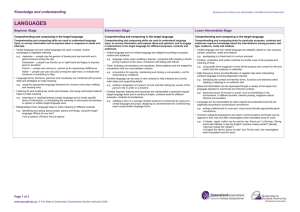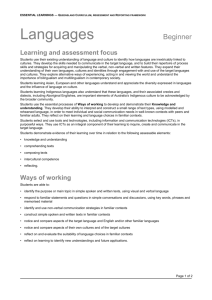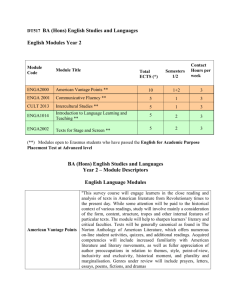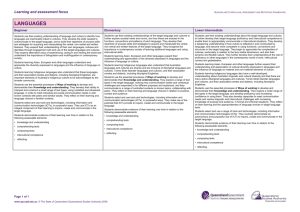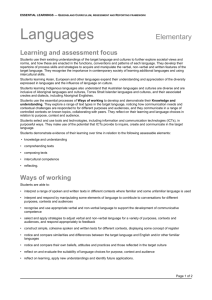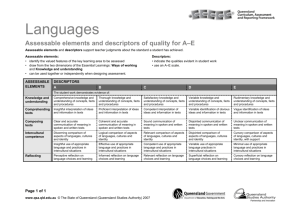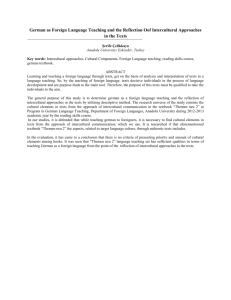DOCX, 26 kB - Queensland Curriculum and Assessment Authority
advertisement
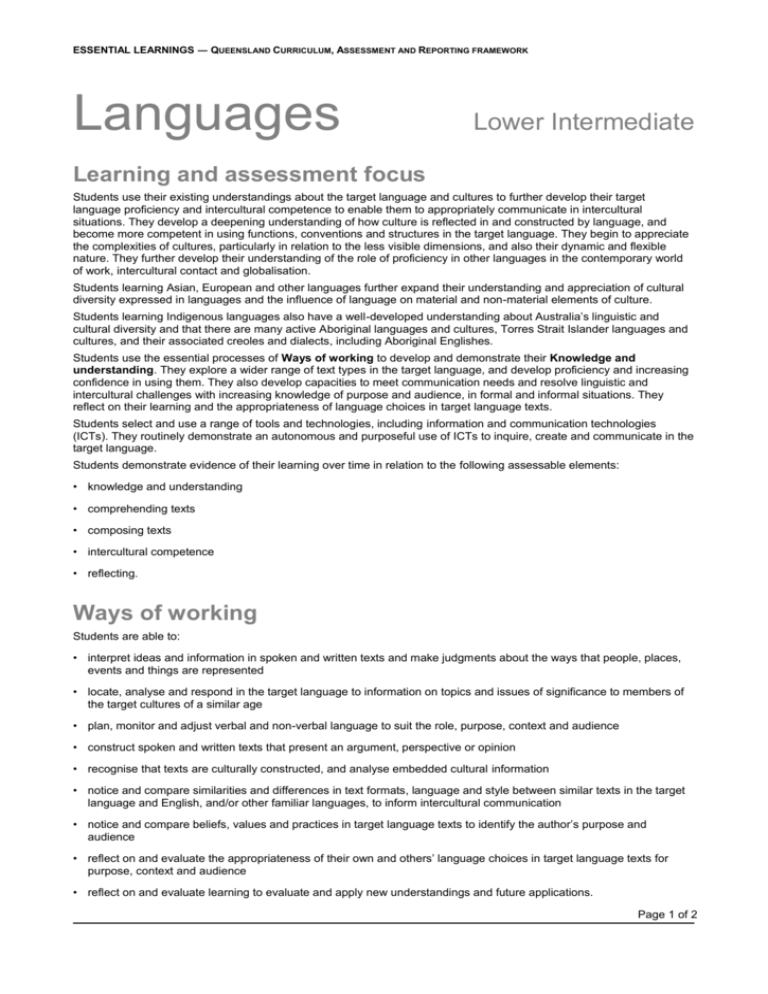
ESSENTIAL LEARNINGS ― QUEENSLAND CURRICULUM, ASSESSMENT AND REPORTING FRAMEWORK Languages Lower Intermediate Learning and assessment focus Students use their existing understandings about the target language and cultures to further develop their target language proficiency and intercultural competence to enable them to appropriately communicate in intercultural situations. They develop a deepening understanding of how culture is reflected in and constructed by language, and become more competent in using functions, conventions and structures in the target language. They begin to appreciate the complexities of cultures, particularly in relation to the less visible dimensions, and also their dynamic and flexible nature. They further develop their understanding of the role of proficiency in other languages in the contemporary world of work, intercultural contact and globalisation. Students learning Asian, European and other languages further expand their understanding and appreciation of cultural diversity expressed in languages and the influence of language on material and non-material elements of culture. Students learning Indigenous languages also have a well-developed understanding about Australia’s linguistic and cultural diversity and that there are many active Aboriginal languages and cultures, Torres Strait Islander languages and cultures, and their associated creoles and dialects, including Aboriginal Englishes. Students use the essential processes of Ways of working to develop and demonstrate their Knowledge and understanding. They explore a wider range of text types in the target language, and develop proficiency and increasing confidence in using them. They also develop capacities to meet communication needs and resolve linguistic and intercultural challenges with increasing knowledge of purpose and audience, in formal and informal situations. They reflect on their learning and the appropriateness of language choices in target language texts. Students select and use a range of tools and technologies, including information and communication technologies (ICTs). They routinely demonstrate an autonomous and purposeful use of ICTs to inquire, create and communicate in the target language. Students demonstrate evidence of their learning over time in relation to the following assessable elements: • knowledge and understanding • comprehending texts • composing texts • intercultural competence • reflecting. Ways of working Students are able to: • interpret ideas and information in spoken and written texts and make judgments about the ways that people, places, events and things are represented • locate, analyse and respond in the target language to information on topics and issues of significance to members of the target cultures of a similar age • plan, monitor and adjust verbal and non-verbal language to suit the role, purpose, context and audience • construct spoken and written texts that present an argument, perspective or opinion • recognise that texts are culturally constructed, and analyse embedded cultural information • notice and compare similarities and differences in text formats, language and style between similar texts in the target language and English, and/or other familiar languages, to inform intercultural communication • notice and compare beliefs, values and practices in target language texts to identify the author’s purpose and audience • reflect on and evaluate the appropriateness of their own and others’ language choices in target language texts for purpose, context and audience • reflect on and evaluate learning to evaluate and apply new understandings and future applications. Page 1 of 2 ESSENTIAL LEARNINGS ― QUEENSLAND CURRICULUM, ASSESSMENT AND REPORTING FRAMEWORK Knowledge and understanding Comprehending and composing in the target language Comprehending and composing texts for particular purposes, contexts and audiences requires knowledge about the interrelations among purpose, text type, audience, mode and medium. • Verbal language and non-verbal language are adapted, based on role, purpose, context, audience, mode and medium e.g. apologising to a friend and to a school principal. • Context, vocabulary and syntax combine to provide cues to the purpose and meaning of texts e.g. using polite forms suggests a more formal purpose and context for the text, and/or that the audience is unfamiliar. • High-frequency forms and identification of register help when interpreting complex language involving dependent clauses e.g. identifying the context and familiar forms, functions and elements when reading or listening to an authentic text. • Ideas and information can be expressed through a variety of text types and language adjusted to suit formal and informal contexts e.g. exploring issues of concern to youth, such as friendships or the environment, in different formats: internet posting, magazine article, informal conversation. • Language can be manipulated to make original and extended texts that are organised according to sociocultural conventions e.g. writing a letter/email to a pen-pal, using socioculturally appropriate genre conventions. • Common colloquial expressions are used in communication and these can be regional in their use and often meaningless when translated word for word e.g. in Osaka, Japan, ookini can be used to say “thank you” in German, Übung macht den Meister is like the English “practice makes perfect” (literally, “exercise makes the master”) in English the idioms “piece of cake” and “hit the road” are meaningless when translated word for word. Intercultural competence and language awareness Intercultural competence and knowledge of languages and cultures allow for differing ways of experiencing, acting in and viewing the world. • Regional and social diversity exists within and across languages and cultures, and this diversity informs appropriate communication e.g. dialects within the target language variations in language associated with generation, gender, social class: Japanese have different words for agebased status relationships (at school, sempai is used to refer to older students and koohai is used to refer to younger students) there are over 250 Aboriginal languages in Australia, based on geographic and kinship groups. • Familiarity with issues and topics of significance to members of the target culture enhances intercultural communication e.g. understanding Indigenous peoples have various sensitivities about representations of deceased persons understanding current youth leisure trends in the target culture informs communication with young people from the target culture understanding religious or traditional taboos helps to make socioculturally appropriate language choices. • Beliefs, values and attitudes are embedded in languages and cultures; and knowledge of these aspects can facilitate intercultural communication e.g. drawing conclusions about attitudes and values shared by speakers of the target language, based on idioms, proverbs or media images, to inform effective intercultural communication. Page 2 of 2
